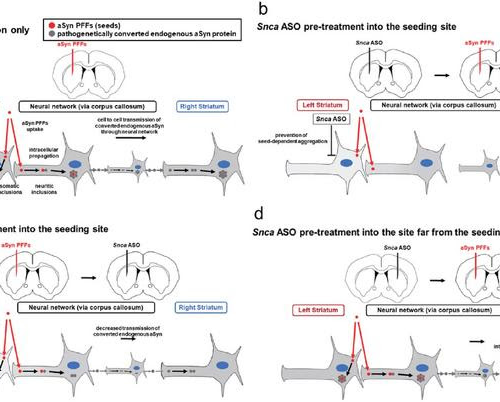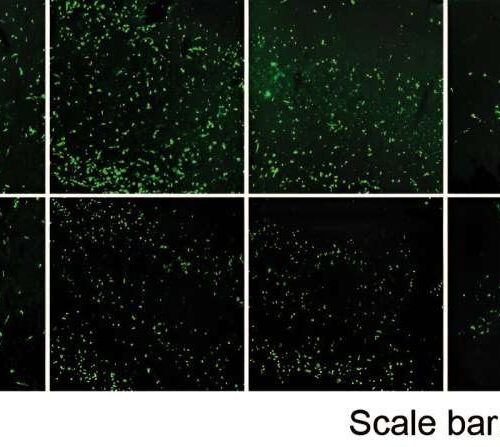September 16, 2024 by Dennis Thompson People with rare genetic variants linked to degenerative brain disorders like Parkinson’s disease are at increased risk of developing ALS, a new study finds. Further, having these genetic variants increases the risk of a person having faster-progressing ALS (amyotrophic lateral sclerosis) and dying earlier, researchers found. The strongest link...
Tag: <span>Parkinson’s disease</span>
Studying the brain in motion offers new insights into Parkinson’s disease
September 5, 2024 by Andrew Dunne, Horizon: The EU Research & Innovation Magazine Credit: CC0 Public DomainA breakthrough in medical imaging is making it possible for researchers to observe brain activity during movement and pick up the early signs of disorders that affect brain-to-body coordination, such as Parkinson’s disease. The researchers are advancing new technology...
Mitochondria keep your brain cells alive: Helping them run smoothly may protect against Parkinson’s disease
August 31, 2024 by Rebecca Zhangqiuzi Fan and Kim Tieu, Florida International University Mitochondria produce the energy that fuels cells. Credit: OpenStax, CC BY-SAIn 1817, a British physician named James Parkinson published An Essay on the Shaking Palsy, describing for the first time cases of a neurodegenerative disorder now known as Parkinson’s disease. Today, Parkinson’s...
Research shows genetic variants are more common in people with Parkinson’s disease than previously thought
July 29, 2024 by Parkinson’s Foundation Credit: Unsplash/CC0 Public DomainInvestigators in the Parkinson’s Foundation-backed PD GENEration study—which reached its goal of 15,000 participants ahead of schedule this spring—found that 13% of participants have a genetic form of Parkinson’s disease (PD), which is a significant observation compared to long-standing estimates. Results from the first 3.5 years...
Antisense oligonucleotide treatment shows promise in treating Parkinson’s disease progression
NEWS RELEASE 25-JUL-2024 Peer-Reviewed PublicationTOKYO MEDICAL AND DENTAL UNIVERSITY IMAGE: RESEARCHERS FROM JAPAN INVESTIGATED HOW ASOS ADMINISTERED LOCALLY INTO THE BRAINS OF MICE MODELS FOR PARKINSON’S DISEASE CAN HELP PREVENT THE FORMATION AND SPREAD OF HARMFUL ASYN AGGREGATES THROUGH DIFFERENT REGIONS. THEIR FINDINGS SHOW ASOS COULD BE A PROMOTING THERAPEUTIC STRATEGY TO BOTH PREVENT AND...
Fruit fly study identifies gene that may reverse Parkinson’s disease
JULY 24, 2024 by Simon Fraser University Cdk8 regulates mitochondrial morphology under physiological conditions. Credit: Nature Communications (2024). DOI: 10.1038/s41467-024-47623-8Researchers at Simon Fraser University, in collaboration with a group from Baylor College of Medicine in Texas, have identified a gene that appears to reverse Parkinson’s disease symptoms in fruit flies. SFU’s Verheyen lab discovered that...
The path to Parkinson’s disease: All roads lead to the nigrosome
JULY 2, 2024 by Tiziano Balzano , Medical Xpress The nigrosome has an intricate and dense network of highways and streets, representing its rich vascularization. This dense network makes the nigrosome a major intersection, a key entry point for traffic, including not only necessary supplies but also potentially harmful elements. Credit: Image created by OpenArt...
Brain connectivity on MRI predicts Parkinson’s disease progression
JUNE 25, 2024 by Radiological Society of North America Credit: Pixabay/CC0 Public DomainThe structural and functional organization of the brain as shown on MRI can predict the progression of brain atrophy in patients with early-stage, mild Parkinson’s disease, according to a study published today in Radiology, a journal of the Radiological Society of North America...
Smartwatches offer window into Parkinson’s disease progression
JUNE 12, 2024 by University of Rochester Medical Center Credit: CC0 Public DomainUbiquitous wearable technologies, like smartwatches, could help researchers better understand progressive neurological disorders like Parkinson’s disease and speed up the approval of new therapies, a critical need given that no drugs exist to slow progression of the world’s fastest growing brain disease. New...
New findings about key pathological protein in Parkinson’s disease open paths to novel therapies
by Johns Hopkins University School of Medicine Second row shows how rapamycin dampens alpha-synuclein protein production in a magnified area of a mouse brain. Credit: Mohammed Khan and Ted Dawson, Johns Hopkins Medicine A so-called pathological protein long associated with Parkinson’s disease has been found in a new study to trigger cells to increase protein synthesis,...










